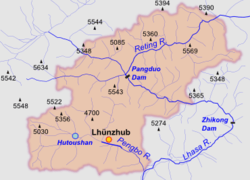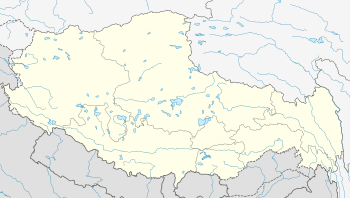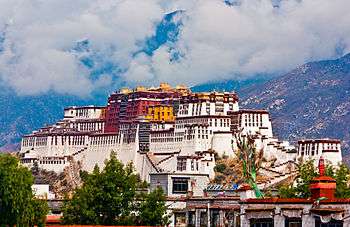Hutoushan Reservoir
| Hutoushan Reservoir Chinese: 虎头山水库 | |
|---|---|
 Hutoushan Reservoir is in the west of Lhünzhub County | |
 Hutoushan Reservoir Location in Tibet | |
| Coordinates | 29°55′5″N 91°5′21″E / 29.91806°N 91.08917°ECoordinates: 29°55′5″N 91°5′21″E / 29.91806°N 91.08917°E |
| Type | Reservoir |
| Basin countries | Tibet, China |
| Water volume | 12,000,000 cubic metres (420,000,000 cu ft)[1] |
Hutoushan Reservoir (Chinese: 虎头山水库, Hutoushan Shuiku) is a man made reservoir in Lhünzhub County, Tibet, to the north of the city of Lhasa. It is an important wintering place for black-necked cranes and other migratory birds.
Location
The reservoir lies in Qangka Township, Lhünzhub County. The reservoir is bordered by large swamps and wet meadows, and has abundant plants and shellfish. It takes its name from a nearby mountain, whose shape was said to resemble a tiger's head.[2] The Hutuoshan Reservoir is the largest in Tibet, with planned total storage of 12,000,000 cubic metres (420,000,000 cu ft). The reservoir lies in the Pengbo River valley.[1]
Black-necked cranes
The endangered Black-necked cranes migrate to the middle and southern part of Tibet every winter, and may be seen on the reservoir.[3] The cranes migrate from the frozen Changtang Grassland in northern Tibet in mid- to late-October, and overwinter in Linzhou (Lhünzhub) County. They return when the weather becomes warmer, in late March. They are the only species of crane that lives and breeds at these high elevations. In 2013 the population in Linzhou County was over 1,000. Village volunteers patrol the 96 square kilometres (37 sq mi) Linzhou Black-necked Crane Preservation Zone, established in 1993, where the cranes eat the remains of farm crops. A monitoring platform has been built to watch the health of the birds.[4] Flocks of the birds stay on the HuTouShan Reservoir overnight, where they can be observed around daybreak before they fly off to search for forage.[5]
References
Sources
- "Lhasa, Tibet Linzhou Hutoushan reservoir is a paradise for photographers". Tibet Travel Web (in Chinese). Retrieved 2015-02-13.
- Lin, Karen (2013-12-12). "Black-Necked Cranes Flocking Back to Tibet". China Tibet Online. Retrieved 2015-02-13.
- "Paradise for Birds - Birds Watching Tour in Lhasa". China Mobile Group Xizang Company. 2014-04-01. Retrieved 2013-02-13.
- Shen, Dajun (July 1995). "Research on the rational use of water resources on the Lhasa River, Tibet" (PDF). Modelling and Management of Sustainable Basin-scale Water Resource Systems (Proceedings of a Boulder Symposium. IAHS. Retrieved 2015-02-13.
- Zhang, Hao (2013-12-16). "Black-necked crane ends winter migration in Lhasa". China Central Television. Retrieved 2015-02-13.


